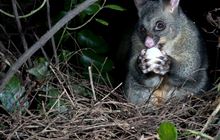Rats
Introduction
The rats in New Zealand are introduced pests and threaten the long-term survival of native species.Image gallery
Description
Three species of rats are present in New Zealand and all of them were introduced here.
Ship and Norway rats
The ship rat (Rattus rattus) is the most commonly found rat in New Zealand and is the smaller of the two European rat species. It has a tail that is longer than its body, and ears that cover the eyes when pressed forward.
Ship rats are widespread around New Zealand on the three main islands and on many offshore islands.
The Norway rat (Rattus norvegicus) is different from the ship rat in that the tail, which is about 18 cm long, is thick and shorter than the body, which is about 20 cm long, and its ear doesn't reach the eye when pressed forward.
Norway rats are more typically associated with human activity and found in urban areas but they have also existed on more than 60 offshore islands.
Successful eradication programmes have occurred on several offshore islands in the last decade, removing the threat of ship and Norway rats from the ecosystem.
Kiore
Kiore is the Māori name for the Pacific or Polynesian rat (Rattus exulans). An adult kiore is approximately 4 cm shorter than an adult ship rat, but looks very similar and the two species are often confused. The tail of a kiore is shorter than the body.
They were once found all around New Zealand and on many offshore islands. On the mainland they are now only found in the south of the South Island.
Kiore are unique because of their association with the migration of Polynesians throughout the Pacific, and their cultural and spiritual values to some iwi Māori. This cultural interest in kiore is recognised by DOC when planning eradication programmes for invasive species.
The threat
Ship and Norway rats and kiore have a major impact in New Zealand because they are omnivores – eating birds, seeds, snails, lizards, fruit, weta, eggs, chicks, larvae and flowers. The varied diet of rats also makes them competitors with native wildlife for food sources.
Ship rats are found in many different habitats around New Zealand and are widespread in lowland podocarp-broadleaf forests. They are good climbers, so they can access many bird nests high in trees.
On offshore islands, Norway rats are large enough to kill burrow-nesting adult seabirds and eat their eggs and chicks.
Along with other prey, kiore have a significant impact on large flightless invertebrates living on the ground, such as our land snails or weta laying their eggs.
You can help to control rats
Regular predator control will help to keep rat numbers low and get us closer to the Predator Free 2050 goal.
DOC's work
Rodents and other predators have been eradicated from several offshore islands which, as nature reserves, are now safe havens for many rare and endangered species.
Methods used to eradicate rodents from offshore islands include trapping, 1080 and Talon-type baits. Recent advances, including the development of more effective anticoagulant poisons and new application methods, mean it is now possible to consider rodent eradication operations on larger islands.
Six official mainland islands have been established. These are areas of intense predator management, making them safe for vulnerable species. But pest control is on-going throughout DOC-managed land.



